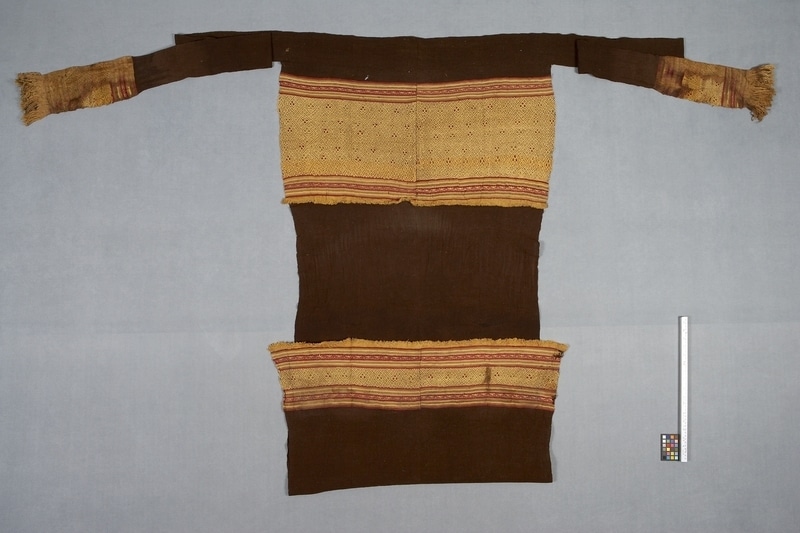Loincloth Item Number: Sf882 from the MOA: University of British Columbia



Description
Loincloth composed of a length of brown fabric with yellow, light brown, dark brown and red ends woven with a geometric pattern. A length of narrow brown fabric with similar borders is sewn across the end of the rectangle with the deeper, decorated border and it extends as long ties in both directions. The main design in the borders is a repetition of double headed serpents in yellow brocade with accents of red and dark yellow. A series of weft-faced stripes in yellows and reds, including a stripe of interlocking hook motifs is symmetrically arranged on either side. The bottom edges of the borders each have a fringe. S-spun single cotton yarns and z-spun, two-plied s camelid (alpaca ?) yarns.
History Of Use
The size of this loincloth relates to the proportions of a mummy bundle, not a human being. It may have been made as part of a matching set of garments specifically for burial. The colours and designs are frequently found on north and central coast fragments. The use of paired, single spun warps and the lack of finish on the underside are typical of Chimu weaving Rowe 1980).
Iconographic Meaning
The double-headed serpent is one of the oldest, most constantly used images in Peru. The interlocked hook design probably derived from images of intertwined serpent bodies. The serpent motif is closely allied to body covering, both the natural covering of fur, feathers and hair and manufactured fabrics.
Item History
What
- Name
- Loincloth
- Identification Number
- Sf882
- Type of Item
- loincloth
- Material
- cotton fibre, alpaca wool fibre ? and dye
- Manufacturing Technique
- spun, plied, woven, dyed and sewn
- Overall
- height 213.0 cm, width 89.0 cm, depth 0.3 cm
Where
- Holding Institution
- MOA: University of British Columbia
- Made in
- Peru
When
- Creation Date
- between 1200 and 1476
- Collection Date
- between 1949 and 1966
- Ownership Date
- before May 4, 1981
- Acquisition Date
- on May 4, 1981
Other
- Item Classes
- textiles
- Condition
- fair
- Accession Number
- 0711/0384